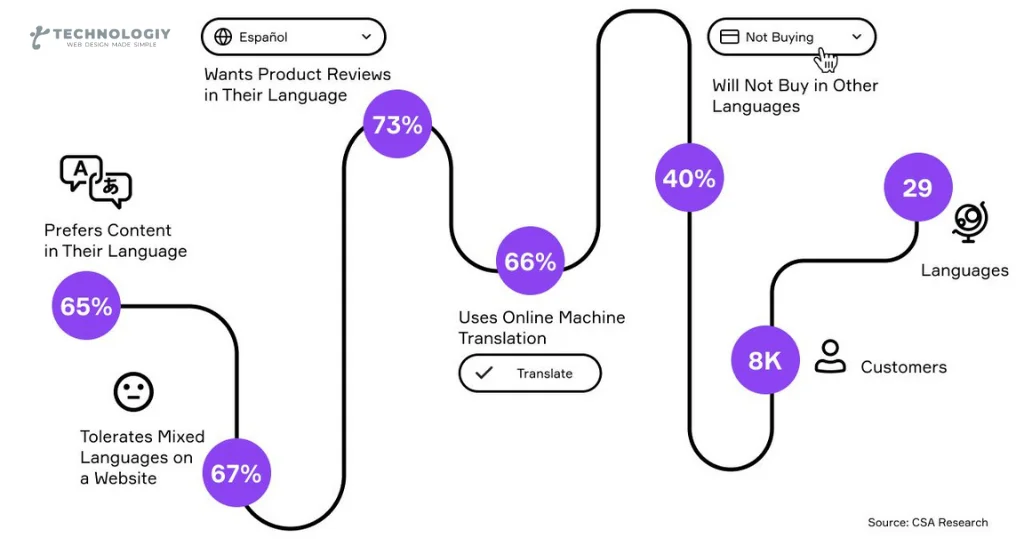Unlocking Global Reach: The Importance of Multilingual Site Localization Introduction:
Welcome, dear readers, to a topic that holds the key to expanding your online presence on a global scale. In today’s interconnected world, reaching a wider audience is no longer a luxury, but a necessity for businesses of all sizes. In this blog post, we will explore the significance of multilingual site localization and how it can empower you to unlock the doors to international success.
Why Multilingual Site Localization Matters:
Imagine a scenario where your website is only available in a single language. While this might suffice for a local audience, it severely limits your reach when attempting to tap into the vast potential of global markets. Multilingual site localization, on the other hand, involves adapting your website to suit the language, culture, and preferences of specific target markets. Here’s why it matters:
Enhances User Experience:
By offering your website in multiple languages, you provide a seamless and user-friendly experience to your international visitors. The ability to navigate and understand information in their native language builds trust, and credibility, and fosters a deeper connection between your brand and your audience.
Overcomes Language Barriers:
Breaking down language barriers is crucial when expanding your global reach. Multilingual site localization allows you to communicate effectively with potential customers who may not be fluent in your language. By speaking their language, you are more likely to engage them, capture their attention, and ultimately convert them into loyal customers.
Increases Search Engine Visibility:
In today’s digital landscape, search engines play a vital role in driving traffic to your website. With multilingual site localization, you optimize your content for different languages, which significantly improves your chances of appearing in relevant search results. This increased visibility enables you to attract organic traffic from diverse regions, boosting your online presence and brand awareness.
Builds Trust and Credibility:
Speaking the language of your target audience demonstrates respect and investment in their culture. By localizing your site, you show that you understand their needs and value their business. This personalized approach builds trust and credibility, leading to better customer loyalty and increased conversion rates.
Outperforms Competitors:
In a fiercely competitive global market, gaining a competitive edge becomes crucial. By investing in multilingual site localization, you set yourself apart from competitors who are yet to embrace this strategy. The ability to connect with customers on a deeper level and deliver tailored experiences can give you a significant advantage when it comes to expanding your market share.
In this interconnected world, multilingual site localization is no longer a mere option but a critical component for businesses aiming to expand their global reach. By investing in this strategy, you unlock the potential to connect with a wider audience, enhance user experiences, and establish trust and credibility within diverse markets. So, take the leap and embark on a journey towards global success by speaking the language of your customers.
Remember, The world is your stage – now it’s time to shine internationally!

Disclaimer: This blog post serves solely as informational content and should not be considered professional advice.
Boost Your Online Presence with Multilingual Site LocalizationIn today’s digital age, having a strong online presence is crucial for any business. With the internet connecting people from all around the world, it’s important to reach out to a wider audience. One effective way to achieve this is through multilingual site localization. By adapting your website to different languages and cultures, you can expand your reach and attract a global audience. In this blog post, we will explore the benefits of multilingual site localization and how it can help boost your online presence.
What is Multilingual Site Localization?
Multilingual site localization involves translating and adapting your website content to target specific languages and cultures. It goes beyond simple translation and ensures that your website resonates with your target audience in different regions. This process includes not only translating the text but also adapting images, videos, and other multimedia elements to suit the cultural preferences and sensitivities of different markets.
The Benefits of Multilingual Site Localization:
Reach a Global Audience:
By localizing your website, you can effectively communicate with customers all around the world. This allows you to tap into new markets and expand your customer base beyond your native language speakers.
Increase Brand Credibility:
When your website is available in multiple languages, it shows that you value and respect the diversity of your audience. This can help build trust and credibility with potential customers, making them more likely to engage with your brand.
Improve User Experience:
Localization ensures that your website is user-friendly for people who speak different languages. This includes using appropriate language, date formats, currencies, and other elements that are specific to the target market. By providing a seamless user experience, you can increase customer satisfaction and encourage repeat visits.
Stand Out from Competitors:
In a crowded online marketplace, multilingual site localization can give you a competitive edge. By offering your website in multiple languages, you differentiate yourself from competitors who only cater to a single-language audience. This can help you attract customers who prefer to browse and shop in their native language.
Enhance SEO:
Localizing your website can also have a positive impact on your search engine optimization (SEO) efforts. By targeting specific keywords in different languages, you can improve your visibility in search engine results and attract organic traffic from various regions. This can lead to higher conversion rates and increased sales.
How to Get Started with Multilingual Site Localization:
Identify Your Target Markets:
Begin by researching and identifying the regions and languages that align with your business goals and target audience. Consider factors such as market size, competition, and cultural relevance.
Translate and Adapt Content:
Work with professional translators who are fluent in the target languages and have a deep understanding of the local culture. Ensure that all aspects of your website, including text, images, videos, and navigation, are accurately translated and culturally appropriate.
Test and Optimize:
Once your localized website is live, monitor its performance and gather user feedback. Continuously optimize your site based on user behavior and preferences to improve engagement and conversions.
Maintain Consistency:
As your business grows and expands into new markets, ensure that your localized websites are regularly updated and aligned with your brand identity and messaging.
Multilingual site localization is an essential strategy for businesses looking to boost their online presence and reach a global audience. By adapting your website to different languages and cultures, you can increase brand credibility, improve user experience, and stand out from competitors. So, why limit yourself to a single language when you can communicate with the world? Start localizing your website today and unlock the full potential of your online business.
Unleashing the Power of Multilingual Site Localization to Amplify Your Brand:
7 Key Steps to Successful Multilingual Site Localization Are you looking to expand your online presence to reach a global audience? If so, it’s crucial to invest in multilingual site localization. By adapting your website content to different languages and cultures, you can effectively connect with diverse audiences and drive more traffic to your site.
We will discuss the 7 key steps to achieving successful multilingual site localization:
Whether you’re a business owner, marketer, or website developer, these steps will guide you through the process and help you create a seamless experience for your international visitors.
Step 1: Define Your Target Audience:
Before diving into the localization process, it’s essential to identify your target audience. Understand their demographics, language preferences, and cultural nuances. This knowledge will help you tailor your content to resonate with their specific needs and interests.
Step 2: Conduct Extensive Keyword Research:
Just like in any SEO strategy, keyword research plays a vital role in multilingual site localization. Identify relevant keywords in your target languages to optimize your content for search engines. This step ensures that your translated content ranks well and attracts organic traffic.
Step 3: Choose the Right Localization Method:
There are various approaches to multilingual site localization, such as using translation plugins, hiring professional translators, or partnering with localization agencies. Evaluate your budget, timeline, and specific requirements to determine the best method for your website.
Step 4: Adapt Content for Cultural Relevance:
Localization goes beyond mere translation. It involves adapting your content to fit the cultural context of your target audience. Consider cultural references, humor, imagery, and idioms that resonate with your international visitors. This step helps build trust and creates a personalized user experience.
Step 5: Optimize User Experience:
A seamless user experience is crucial for the success of your multilingual site. Ensure that your website’s navigation, layout, and functionality are user-friendly across all languages. Pay attention to factors such as text direction, font styles, and date and number formats. Test your site thoroughly to identify and fix any issues.
Step 6: Implement SEO Best Practices:
Apply SEO best practices to your localized content. Optimize meta tags, headings, URLs, and alt tags in your target languages. Build quality backlinks from relevant international websites to improve your site’s visibility in search engine results.
Step 7: Monitor and Update:
Multilingual site localization is an ongoing process. Monitor the performance of your localized content, analyze user behavior, and make necessary updates.
By following these 7 key steps, you can successfully localize your website for a global audience. Remember, multilingual site localization is not just about translating words; it’s about creating an immersive experience that resonates with your international visitors.
